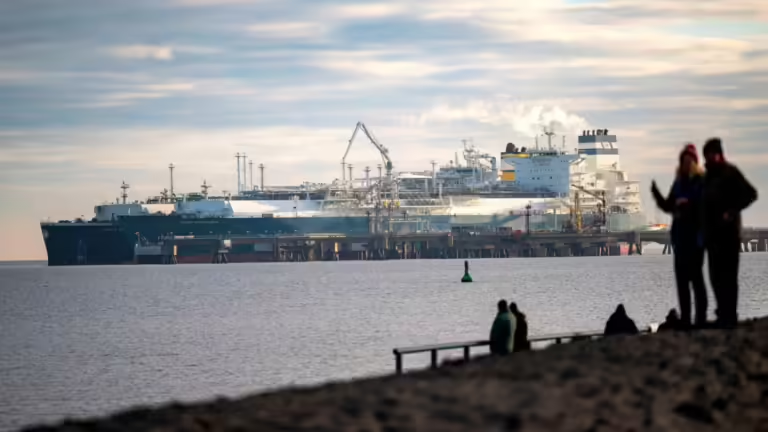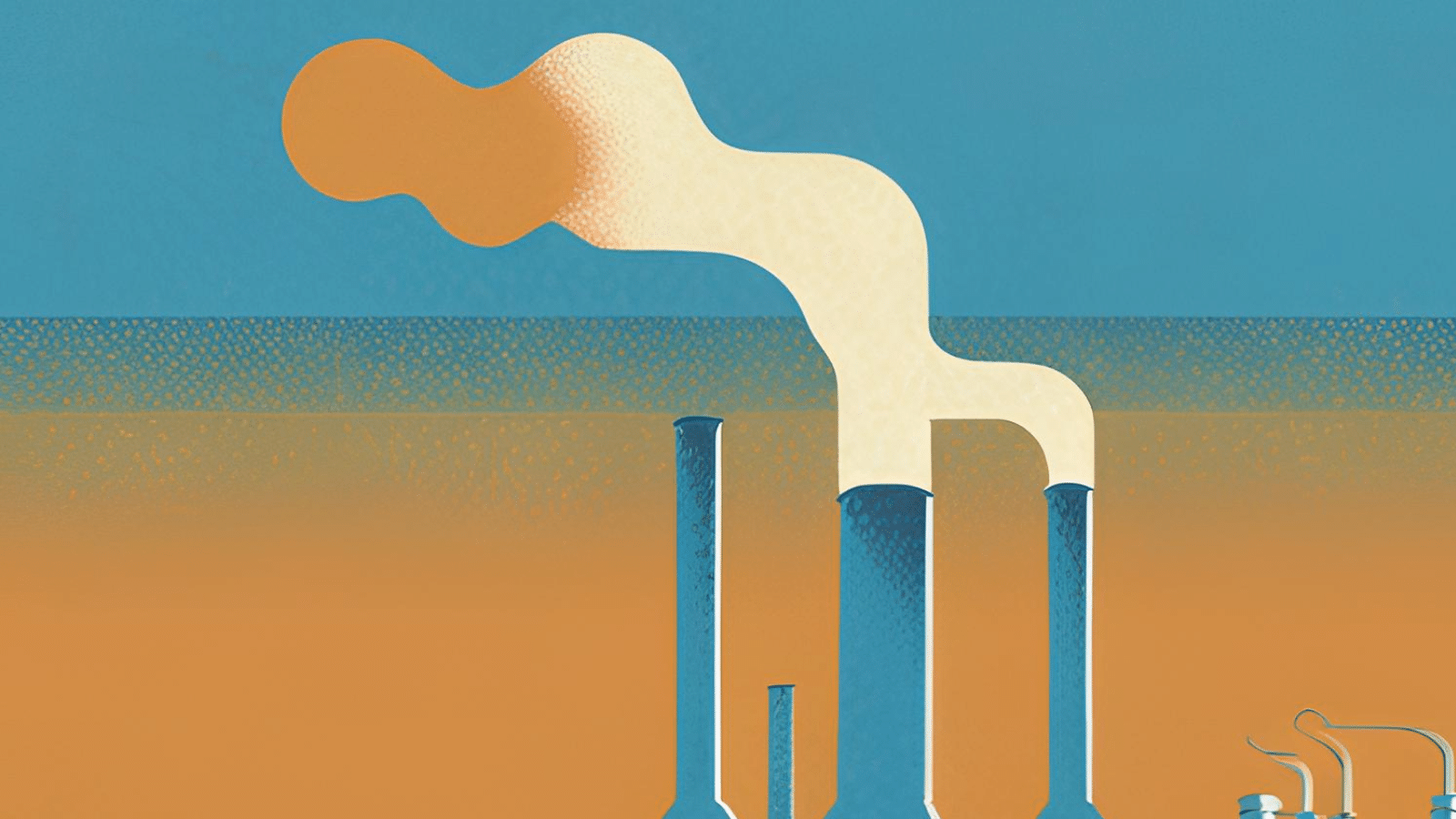This website uses cookies as well as similar tools and technologies to understand visitors’ experiences. By continuing to use this website, you consent to Columbia University’s usage of cookies and similar technologies, in accordance with the Columbia University Website Cookie Notice.
Energy Explained
Insights from the Center on Global Energy Policy
This Energy Explained post represents the research and views of the author. It does not necessarily represent the views of the Center on Global Energy Policy. The piece may be subject to further revision. Contributions to SIPA for the benefit of CGEP are general use gifts, which gives the Center discretion in how it allocates these funds. Rare cases of sponsored projects are clearly indicated.
For a full list of financial supporters of the Center on Global Energy Policy at Columbia University SIPA, please visit our website at Our Partners. See below a list of members that are currently in CGEP’s Visionary Circle. This list is updated periodically.
China’s latest Natural Gas Development Report shows the nation made gains last year in efforts to restructure its natural gas market, increasing domestic production and consumption; boosting imports of liquefied natural gas; adopting technologies to boost domestic exploration and production and cut emissions; and reforming pipeline transmission tariffs.[1] The new tariffs are likely to help grow natural gas supplies, reduce end-user costs and increase consumption. The world’s top importer of natural gas now supplies about 60 percent of its demand with domestic supplies, thanks in part to reforms aimed at increasing domestic supplies and consumption. As the world takes on many challenges from climate change and energy transition, China’s use and views of natural gas in its energy mix are critically important. In this blog, the authors explore these key takeaways from the 2023-2024 report.
Industry and city-gas drove China’s natural gas consumption in 2023
In 2023, China consumed 394.5 billion cubic meters (bcm) of gas, a year-on-year increase of 7.6 percent. Industry and city gas, which includes residential and transport use, accounted for most of the incremental demand growth of 28.2 bcm. While industry was the largest contributor to this growth (12.3 bcm) and the largest sectoral consumer, city gas was the fastest-growing sector (Table 1). Its double-digit increase was partly due to the “explosive growth” of heavy-duty trucks powered by LNG.[2] Indeed, 152,000 LNG-powered heavy-duty trucks were sold in 2023, a year-on-year increase of 307 percent.[3] This growth continued in the first half of 2024, with sales of LNG-fueled heavy-duty trucks surging by 104 percent year-on-year. These sales contributed to an 8.7 percent year-on-year increase in China’s natural gas consumption to 210.8 bcm in the first half of 2024.[4] Sales continued to grow year-on-year in July but fell in August due to the increase in LNG prices, the narrowing of oil and gas price differentials and the absence of new policy support.[5]
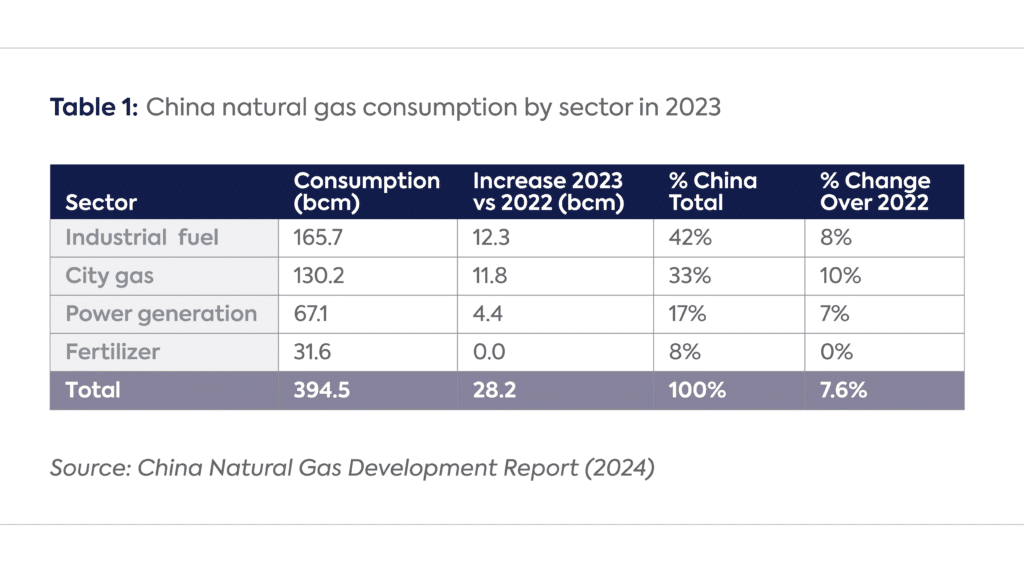
More than 40 percent of Chinese domestic gas production was from unconventional sources in 2023
In 2023, China produced 232.4 bcm domestically, an increase of 12.3 bcm or 5.6 percent over 2022. Domestic output met some 59 percent of China’s total demand, keeping import dependence at 41 percent, unchanged from last year. According to the report, 43 percent of domestic gas production, 97 bcm, was from unconventional sources (Figure 1).
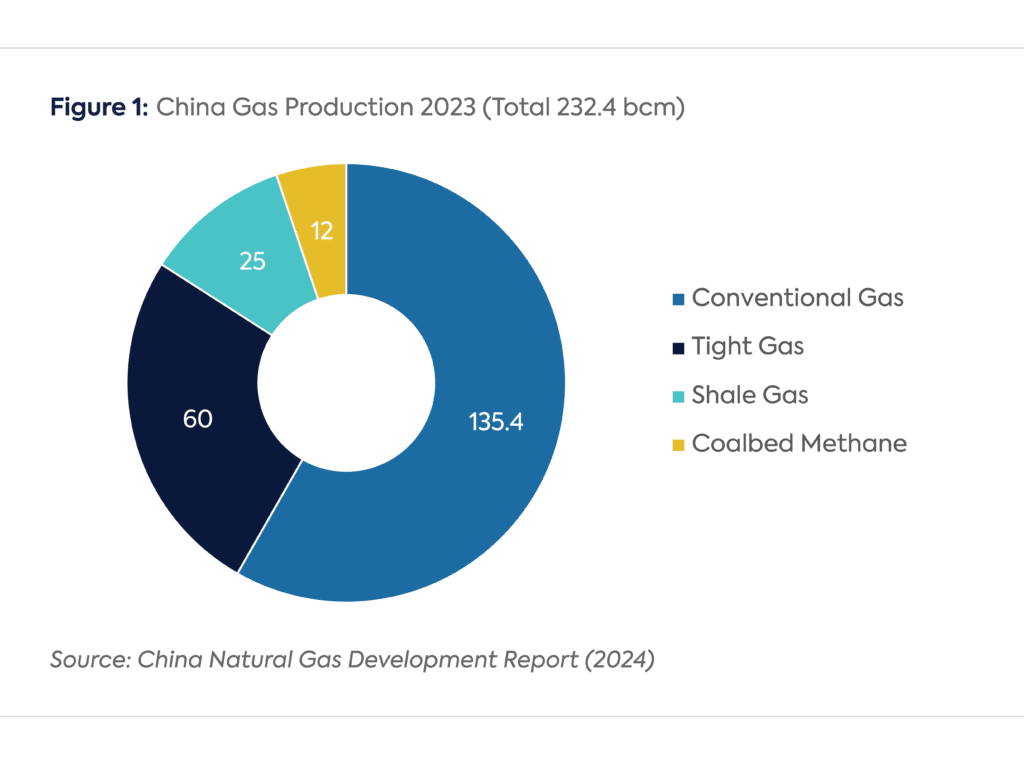
China has been investing heavily in domestic oil and gas exploration, development and production (E&P) since 2019, partly due to Chinese leader Xi Jinping’s July 2018 instruction to China’s national oil companies (NOCs) to increase domestic E&P.[6] In 2019, the three major NOCs released their first ever seven-year plans to intensify E&P in 2019-2025.[7] Xi subsequently announced that China must reduce dependence on imported oil and gas.[8] Chinese NOCs have implemented this strategy with significantly higher capital investment in domestic E&P. The three major NOCs collectively increased their domestic gas production by 43 percent in 2018-2023, setting new production records last year.[9]
China’s LNG imports rose by over 12 percent
China continues to import more LNG than pipeline gas (Figure 2). In 2023, 59 percent of China’s natural gas imports of 165.5 bcm were LNG and 41 percent were pipeline gas. The country’s LNG imports rebounded by growing 12.3 percent, and China replaced Japan as the world’s largest LNG importer on an annual basis.[10] However, China LNG imports remained below their peak of 108.9 bcm (or 79.5MT) in 2021.
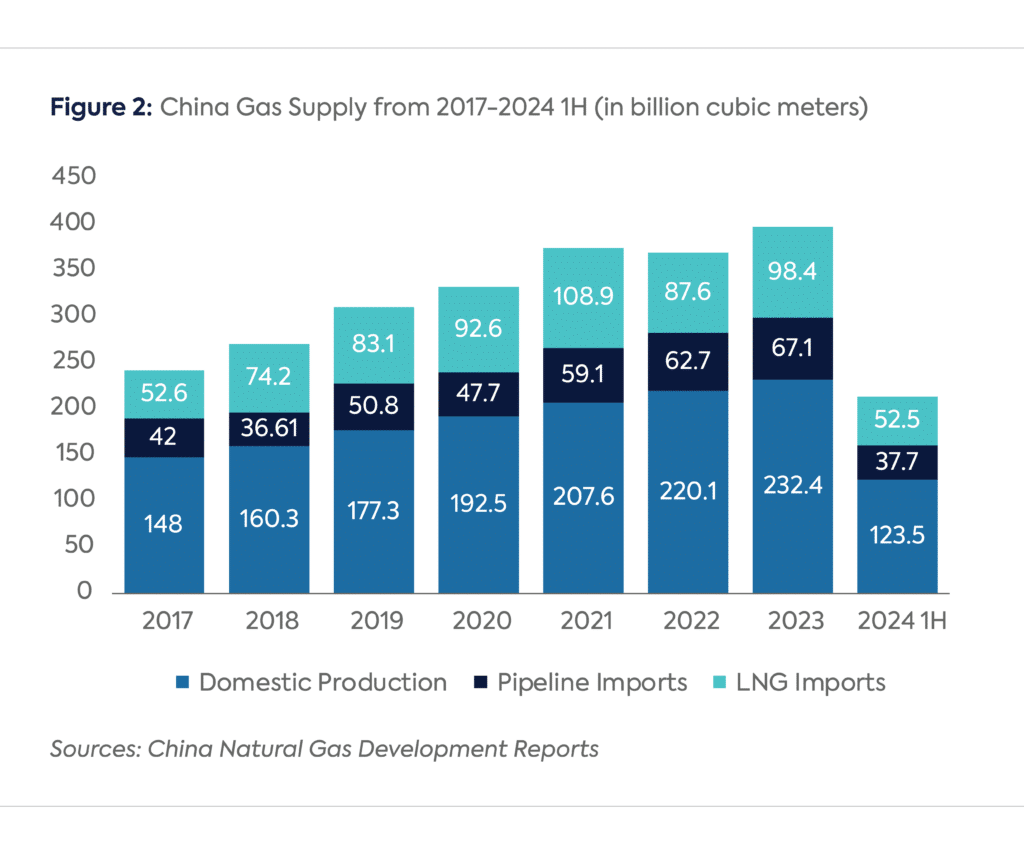
Australia, Qatar, Russia, and Turkmenistan supplied nearly three-quarters of China’s natural gas imports.[11] New long-term supply contracts signed by Chinese buyers and growth in China’s regasification capacity indicate that China’s LNG imports will probably continue to grow. Chinese imports increased by over 14 percent during the first half of 2024.[12]
China made technological breakthroughs to promote natural gas production and consumption
The report highlighted a number of technological breakthroughs consistent with China’s emphasis on independent research, design and production of key equipment to counter the perceived risk of potential Western technology export bans directed at China.[13] Four new technologies are worth noting. The first two aim to facilitate energy transition and emission reduction, while the second two aim to explore and develop oil and gas either in deepwater settings or deep-seated reservoirs:
- Simultaneous power generation using geothermal energy from hot water, encountered in deep oil and gas development wells
- Power generation by using pressure differentiation from natural gas.[14] This is claimed to be a net zero emission technology.
- Independently developed “Hai-Jing” system[15] to reduce noise levels to conduct high-resolution 3D seismic surveys in ultra-deepwater (>3,000m) areas such as the South China Sea.
- Automated rigs for ultra-deep (>12,000m) drilling, deployed in the Tarim Basin in western China.
Pipeline transmission tariff reform moves forward
On January 1, 2024, China implemented a new pipeline transmission tariff system for inter-provincial pipelines operated by PipeChina, which controls more than 60 percent of the country’s oil and natural gas pipelines.[16] The new system replaces 20 tariffs with one each for four zones: Northwest, Northeast, Southwest, and Central and East.[17] It aims to further the objective for which Beijing established PipeChina in 2019 – the creation of a unified national pipeline network to increase supplies, lower end-user costs and boost consumption.[18]
Although the new system has reduced tariffs across China, some pipelines now have higher tariffs while others have lower ones (Figure 3).[19] The Northwest is the zone with the lowest tariff, probably because it is a strategic import channel for natural gas from Central Asia. The second lowest tariff is for the Northeast, which is a strategic import channel for Russian gas. The highest tariff is for the Southwest; it only contains the China-Myanmar pipeline, the tariff for which has declined by 15 percent. Several pipelines in the Central and East, the country’s main natural gas consumption center and a transit zone, now have higher tariffs.
The new system is likely to lead to an increase in China’s natural gas supply and consumption. The zonal tariffs should make it easier for downstream companies to shop around for cost-competitive supplies because it is easier to compare prices.[20] This, in turn, should lead to lower upstream costs as producing companies compete against each other to secure customers.[21]
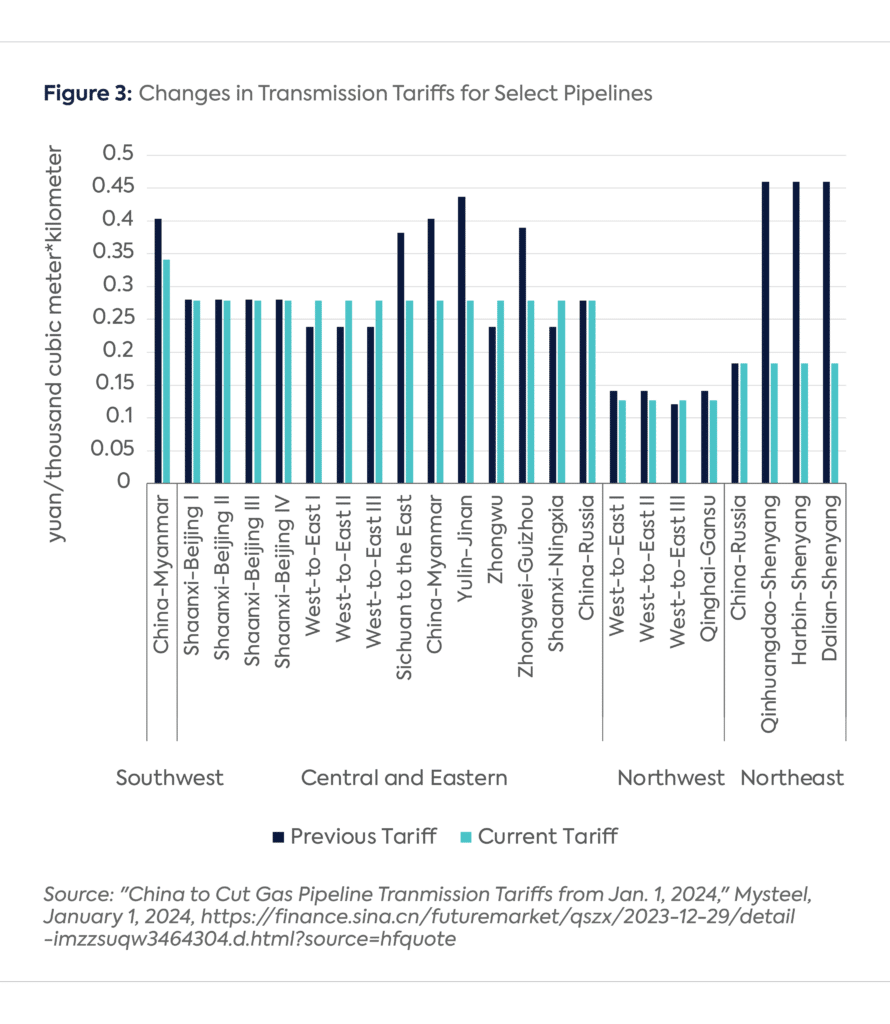
Gas market conditions in 2024 seen as favorable to China’s goals
China sees a well-supplied global gas market, leading to a volatile but generally declining price environment it believes will be supportive of the “recovery and improvement” of its gas market. The report anticipates lower global gas demand growth due to weak global economic recovery, especially in the manufacturing sector. There are, however, a number of risk factors such as geopolitical tensions, sanctions and anti-sanction moves, and extreme weather conditions.
The report projects that China will consume 420 – 425 bcm of gas in 2024, an increase of 6.5 – 7.7 percent over 2023. It also expects domestic gas production to reach 246 bcm, and imports to rise to 174-179 bcm. As Table 2 indicates, these projections indicate that China gas demand might grow more slowly in 2024 than in 2023 and the previous six years, whereas growth in total gas imports might be significantly lower than in 2023 and in the past 6 years, as domestic production continues to rise at a pace higher than that of 2023.
CGEP’s Visionary Circle
Corporate Partnerships
Occidental Petroleum Corporation
Tellurian Inc
Foundations and Individual Donors
Anonymous
Anonymous
the bedari collective
Jay Bernstein
Breakthrough Energy LLC
Children’s Investment Fund Foundation (CIFF)
Arjun Murti
Ray Rothrock
Kimberly and Scott Sheffield
[1] Editorial Committee for “China Gas Development Report (2024), ed., 中国天然气发展报告(2024) (China Gas Development Report 2024), (Beijing: Petroleum Industry Press, July 2024), https://www.nea.gov.cn/1310782456_17217223060611n.pdf. The report is led by the National High-end Think Tank Research Center, guided by three leading Chinese energy agencies: 1) Oil and Gas Division, National Energy Administration, 2) Resources and Environment Policy Center, Development Research Center of State Council, and 3) Oil and Gas Strategic Resources Research Center, Ministry of Natural Resources.
[2] China Natural Gas Development Report 2024, p. 5.
[3] Hou Ruining, “终结“20连涨”,天然气重卡8月销量下滑预超三成” (Ending the “20 consecutive rises”, natural gas heavy truck sales fell by more than 30% in August), 界面新闻 (Jiemian News), September 6, 2024, https://m.jiemian.com/article/11684142_microcontent.html.
[4] China Natural Gas Development Report 2024, p. 5.
[5] Hui Ruining, “Ending the 20 Consecutive Increases.”
[6] Erica Downs, “High Anxiety: The Trade War and China’s Oil and Gas Supply Security,” Center on Global Energy Policy, School of International and Public Affairs, November 2019, p. 6, https://www.energypolicy.columbia.edu/wp-content/uploads/2019/11/ChinaTradeWar_CGEP_Commentary_111519.pdf
[7] Erica Downs, “High Anxiety: The Trade War and China’s Oil and Gas Supply Security,” Center on Global Energy Policy, School of International and Public Affairs, November 2019, p. 6, https://www.energypolicy.columbia.edu/wp-content/uploads/2019/11/ChinaTradeWar_CGEP_Commentary_111519.pdf.
[8] “习近平:能源的饭碗必须端在自己手里” (Xi Jinping; the energy rice bowl must be held in our own hands), 中国新闻网, China News Online, October 22, 2021, https://www.chinanews.com/gn/2021/10-22/9592442.shtml.
[9] “2018-2023年中国天然气产量” (China’s natural gas production in 2018-2023) 国际石油经济 (International Petroleum Economics), April 2024, p. 105, China Academic Journals database; and Zheng Xin, “Three oil giants set production records last year,” China Daily, March 27, 2024, https://www.chinadaily.com.cn/a/202403/27/WS6603767fa31082fc043bee12.html. The three major NOCs are CNPC, Sinopec Group and CNOOC.
[10] Energy Institute, 2024 Statistical Review of World Energy, June 2024; data file, Gas – LNG imports BCM tab, EI-Stats-Review-All-Data.xlsx (live.com)
[11]2024 Statistical Review of World Energy, pp. 42, 44-45.
[12] “Chinese natural gas imports edge higher in June but are still over 14 percent up in first half of 2024,” LNG Journal, July 12, 2024, https://lngjournal.com/index.php/latest-news-mainmenu-47/item/111624-chinese-natural-gas-imports-edge-higher-in-june-but-are-still-over-14-percent-up-in-the-first-half-of-2024.]
[13] Simone McCarthy, “China’s Communist Party meets to set direction for troubled economy,” CNN, July 14, 2024, https://www.cnn.com/2024/07/14/economy/china-communist-party-third-plenum-economy-intl-hnk/index.html.
[14] 我国单机装机容量最大天然气压差发电项目建设纪实-中国石油新闻中心-中国石油新闻中心(Actual reports for the construction of electricity generation project using natural gas pressure differences for the largest capacity single power turbine in China), 中国石油中心 (CNPC News Center), June 14, 2024, http://news.cnpc.com.cn/system/2024/06/14/030134664.shtml; and Zhi-Dong Li, Qing-Lin Cheng, You-Wang Chen, Jiang-Dong Wei, Li-li Lv, Hao Wu, and Yan Liu, “Electric power generation technology of natural gas pressure reduction: Insights from black box-gray box hierarchical exergy analysis and evaluation method” , Petroleum Science 19, pages 329 – 338, 2022, https://www.cup.edu.cn/petroleumscience/docs/2022-03/c99935e3ac264a0ebb462d7cc541f859.pdf..
[15] “首次实现三千米深海“CT扫描”,我国自主研发的“海经”系统有多神”(How great is the “Hai-Jing” system to achieve first “CT scan” in >3000 m ultra deep water?), 钱江晚报 (Qianjiang Evening News),
September 10, 2023, https://www.sohu.com/a/726715408_121627717
[16] Luo Guoping and Lu Yutong, “PipeChina Completes Gas Pipeline Network with Kunlun Energy Acquisition,” Caixin Global, April 1, 2021, https://www.caixinglobal.com/2021-04-01/pipechina-completes-gas-pipeline-network-with-kunlun-energy-acquisitions-101684830.html.
[17] National Development and Reform Commission, “国家发展改革委首次分区域核定跨省天然气管道运输价格” (The National Development and Reform Commission has approved cross-provincial natural gas pipeline transmission tariffs by region for the first time), December 5, 2023, https://www.ndrc.gov.cn/xxgk/jd/jd/202312/t20231205_1362438.html.
[18] Ibid., and Erica Downs and Sheng Yan, “Reform is in the Pipelines: PipeChina and the restructuring of China’s Natural Gas Market,” Center on Global Energy Policy, School of International and Public Affairs, Columbia University, September 16, 2020, https://www.energypolicy.columbia.edu/publications/reform-pipelines-pipechina-and-restructuring-china-s-natural-gas-market/.
[19] This paragraph is based on”张雄君:跨省天然气管道分区定价的影响与下一步改革建议” (Zhang Xiongjun: The impact of inter-provincial natural gas pipeline zonal pricing and next-step reform suggestions),新浪财新(Sina Finance), December 29, 2023, https://finance.sina.cn/futuremarket/qszx/2023-12-29/detail-imzzsuqw3464304.d.html?source=hfquote; “China to cut gas pipeline transmission tariffs from Jan 1, 2024,” MySteel, January 1, 2024, https://www.mysteel.net/news/5046321-china-to-cut-gas-pipeline-transmission-tariffs-from-jan-1-2024; and Erica Downs’ email exchange with Neil Beveridge, August 15, 2024.
[20] “China’s New Gas Pipeline Tariff Mechanism to Facilitate Direct Sales,” Fitch Ratings, April 23, 20231, https://www.fitchratings.com/research/corporate-finance/china-new-gas-pipeline-tariff-mechanism-to-facilitate-direct-sales-23-04-2021; and Kai Dong and Miaoru Huang, “China’s zonal gas transmission tariff: changes and implications,” March 26, 2024, https://www.woodmac.com/news/opinion/chinas-zonal-gas-transmission-tariff-changes-and-implications/.
[21] Ibid.
More on Energy Explained Energy Explained
The Future of LNG Trade: Inflexible, Inefficient, and Polarized?
This Energy Explained post represents the research and views of the author. It does not necessarily represent the views of the Center on Global Energy Policy. The piece...

US Exports and Domestic Gas Use Face Off for Incremental Supply
This Energy Explained post represents the research and views of the author. It does not necessarily represent the views of the Center on Global Energy Policy. The piece...
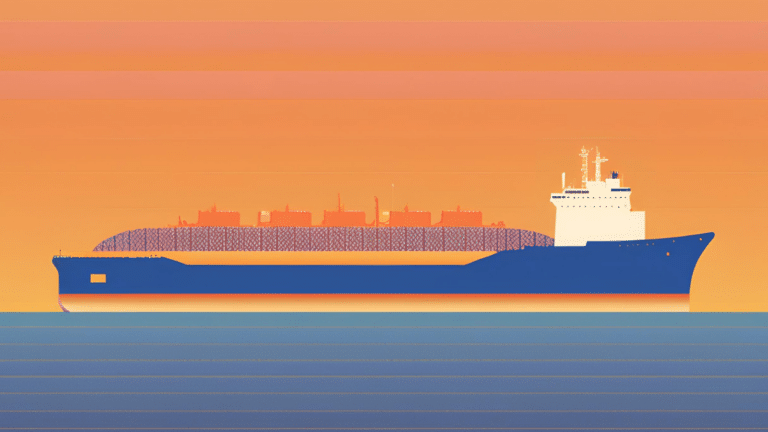
Oil and Gas Industry Takeaways from China’s ‘Two Sessions’
This Energy Explained post represents the research and views of the author. It does not necessarily represent the views of the Center on Global Energy Policy. The piece...
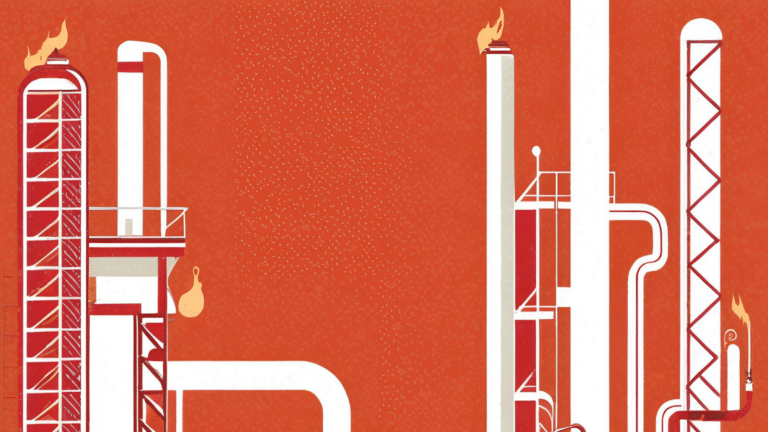
Bridging the US-EU Trade Gap with US LNG Is More Complex than It Sounds
This Energy Explained post represents the research and views of the author. It does not necessarily represent the views of the Center on Global Energy Policy. The piece...
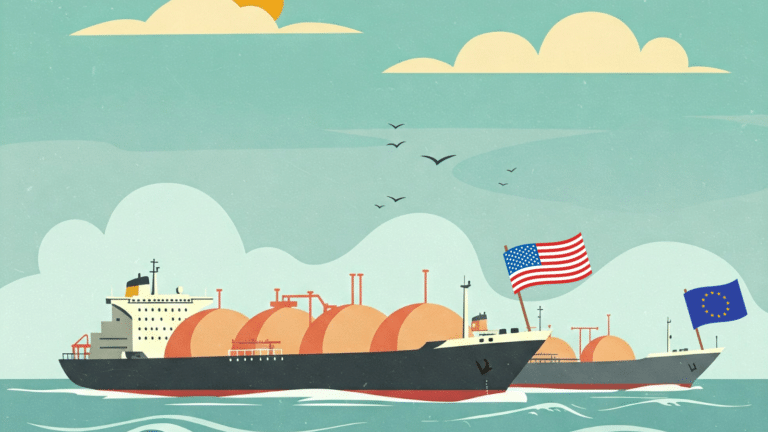
Relevant
Publications
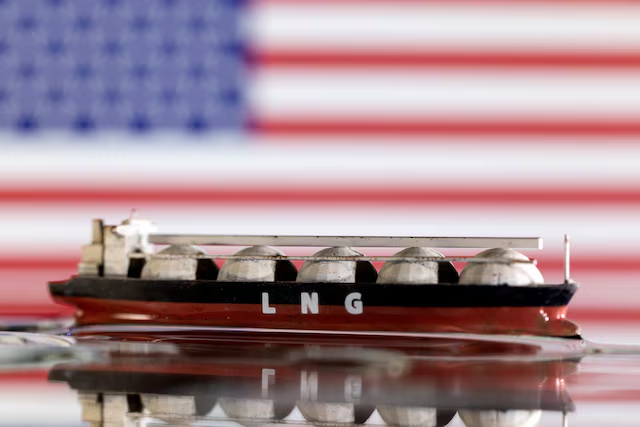
The U.S. Should Not Politicize LNG Exports
Can U.S. gas exports throw a lifeline to Europe without raising prices at home?
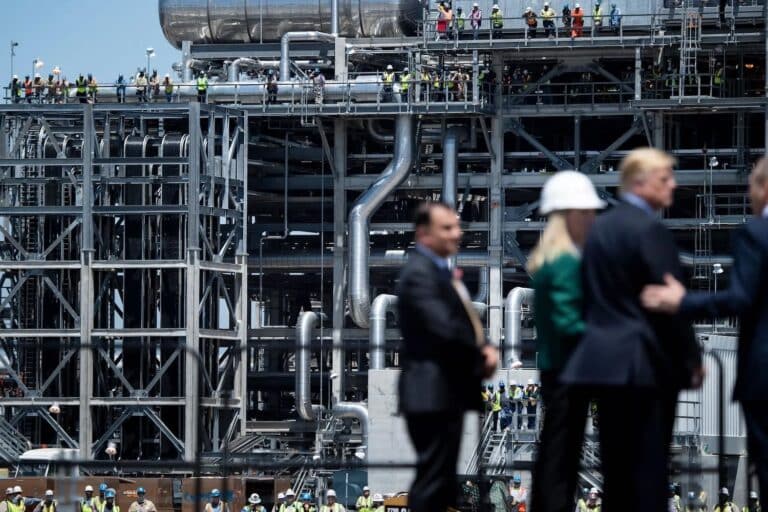
Donald Trump’s mixed signals for gas market
Incoming administration’s policies might eventually lead to decrease in US LNG exports to EU
